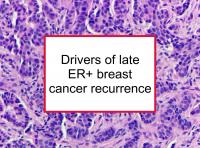While some types of cancer can be considered to be cured after five years without a relapse, breast cancer has a long natural history and can recur many years after initial diagnosis and treatment. Early relapse is most likely with aggressive forms of breast cancer such as triple negative (ER-/PR-/HER2-) and HER2-positive (HER2+) disease.
However, while hormone receptor positive breast cancer (ER+/PR+/HER2-) tends to be more indolent, it is more likely to recur many years after diagnosis than more aggressive types. One study reported that while the risk of recurrence was lower at first for ER+ compared to ER- disease, ER+ tumor status was more detrimental after 7.7 years. Now a meta-analysis of data from previous studies has reported that the risk of late distant recurrence among women with ER+ disease who have completed five years of endocrine treatment is positively associated with the size and number of positive lymph nodes of the original tumor.
Risk of breast cancer recurrence remains for decades
As noted above, the risk of breast cancer relapse persists for many years. Late relapse is thought to be caused by dormant breast cancer cells that have found their way to the bone marrow. These tumor cells evaded eradication because they were not dividing at the time of treatment. One study found that the risk of recurrence between years five to 12 averages approximately 4% per year. Other studies have found that the rate of recurrence for early stage breast cancer after the 10-year mark is 1% to 2% overall. While rare, recurrences as long as 35 years after the initial breast cancer diagnosis have been reported.
Daily alcohol consumption and cigarette smoking both have been found to be associated with increased risk of late recurrence whereas regular exercise may reduce it. Obesity also increases the risk of late recurrence. One study reported that the risk of developing distant metastases after 10 years was 46% higher among obese women after adjusting for disease characteristics. The risk of dying as a result of breast cancer after 30 years was also found to be 38% higher among obese women. Treatment with tamoxifen for 10 years (rather than five) has been shown to reduce late recurrence in ER+ breast cancer patients.
Latest research links tumor characteristics to late recurrence
The study referenced above was designed to investigate the associations between tumor characteristics and late recurrence among women who complete five years of endocrine therapy (aromatase inhibitor or tamoxifen). Five years of endocrine treatment has been shown to substantially reduce recurrence rates both during and after treatment in women with early stage ER+ disease. Extending such treatment beyond five years offers further protection but at the cost of worsening side effects. Identifying factors associated at higher risk of late recurrence could help determine whether to continue treatment.
To conduct the study, the authors performed a meta-analysis of data from previous studies. The analysis included 88 trials with 62,923 female participants with ER+ breast cancer who completed five years of endocrine treatment and were disease-free after completing this therapy. The authors performed statistical analyses to determine the associations of tumor size, lymph node status (TN), tumor grade, and other factors with breast cancer outcomes during the following 15 years. Breast cancer relapses were found to take place at a steady rate throughout the study period.
The risk of distant recurrence (i.e., not in the breast, chest wall, or lymph nodes) was strongly associated with the original TN status. Among the patients with stage T1 ( tumor ≤ 2 cm in diameter) disease, the risk of distant recurrence was 13% when there had been no positive lymph nodes at diagnosis (T1N0), 20% when one to three nodes had been positive (T1N1-3), and 34% for those with four to nine positive nodes (T1N4-9). For women with stage T2 disease (between 2 cm and 5 cm), the risks were 19% for those with negative lymph nodes (T2N0), 26% for T2N1-3, and 41% for T2N4-9. Breast cancer-specific death was similarly linked TN status, however contralateral breast cancer risk was not.
For a given TN status, tumor grade and Ki-67 (which are strongly correlated with each other), had only modest independent predictive value for distant relapse. In addition, progesterone receptor (PR) and HER2 status (in 15,418 patients in trials with no use of trastuzumab (Herceptin)) were not predictive. The absolute risk of distant recurrence among patients with T1N0 breast cancer was found to be 10% for low-grade, 13% for moderate-grade, and 17% for high-grade tumors. The comparable risks of any recurrence or a contralateral breast cancer were 17%, 22%, and 26%, respectively. The authors conclude that breast cancer relapses continued to occur at a steady rate for the following 15 years among women with ER+ disease who completed five years of endocrine treatment. Furthermore, the risk of distant recurrence was strongly associated with the original TN status, with risks ranging from 10 to 41%, depending on TN status and tumor grade.
Please click on our tag late recurrence for more information.
